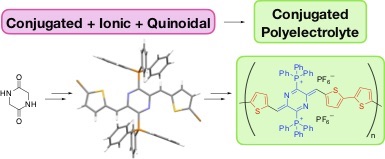By Laurie Chong

Photothermal therapy (PTT) is a proposed treatment for diseases like antibacterial-resistant infections and cancer, but despite over a decade of research, scientists have been unable to find a safe and effective chemical agent to use in the process. Now, a team of researchers has designed a new type of organic compound that could be used as an effective therapeutic agent.
Recently published in the journal Angewandte Chemie, a team of scientists led by researchers at the Molecular Foundry has demonstrated that their new materials, a type of conjugated polyelectrolyte (CPE), can cause a 95% reduction in bacterial colony count within five minutes under infrared irradiation. This finding marks one of the first examples of using a CPE as an active agent in PTT.
Organic polymers are made by connecting many repeating subunits like beads on a string. If those subunits contain ionic groups, the polymers are called polyelectrolytes, and in the cases when the subunits are fully connected by alternating single and double bonds, they are called conjugated polyelectrolytes. Their unique properties, like water solubility, conductivity, and light absorption have led to their extensive use in optoelectronics, sensing, and imaging applications. But CPEs had not been applied as photothermal therapeutic agents before because ionic polymers that can absorb light in the near infrared (NIR) range, where it is most desirable for PTT, are very rare.
The research team led by Yi Liu, facility director of the Foundry’s Organic and Macromolecular Nanostructures facility, was working on a method to make CPEs for organic electrochemical transistors (OECTs). They hypothesized that attaching the ionic (or charged) groups directly to the conjugated polymer main chain would produce effective OECT active materials but discovered their material might have another use.
“We developed a way to synthesize a CPE from ionic azaquinodimethane (iAQM) building blocks so that it carries charges and has one of the lowest observed band gaps for this type of polymer,” said Liu. “We weren’t originally planning to create a material useful for photothermal therapy, but found that the ionic polymer we made also strongly absorbs near-infrared light.”
Photothermal therapy relies on using an active chemical agent that absorbs light and dissipates the energy as heat. Gold nanoparticles and carbon allotropes have most extensively been explored as the active agents in PTT, but both suffer from the lack of any known metabolic breakdown pathway and may be harmful to the body over long periods of time. Organic molecules like CPEs are a promising alternative, as they are more likely to be metabolized by the body after their therapeutic use.
“Previous CPEs have rarely been demonstrated to have high photothermal conversion efficiency,” said Liu. “Our newly designed iAQM motif is intrinsically ionic, and once incorporated into polymer, it gives rise to CPEs with the right absorption characteristics for efficient photothermal conversion. The charges in CPEs make them more soluble in polar solvents and thus more biologically relevant since it could be tailored to bind to specific proteins or cells.”
The researchers used X-rays at Berkeley Lab’s Advanced Light Source to determine the structure of their synthesized polymers, allowing them to understand how molecule structure affects polymer performance.
The researchers also tested their polymer on cultures of Staphylococcus aureus, a model system with relevance to antibiotic-resistant bacterial infection, and found that cultures treated with the iAQM polymer that were then irradiated with 808 nm light resulted in a 95% reduction in the bacterial colony count, compared to 30% treated with the polymer alone and 10% when only irradiated.
The results show that the researchers’ method of making CPEs is a promising way to make functional ionic organic semiconductors with useful properties, and that iAQM-based CPEs in particular are potent photothermal antibacterial agents.

